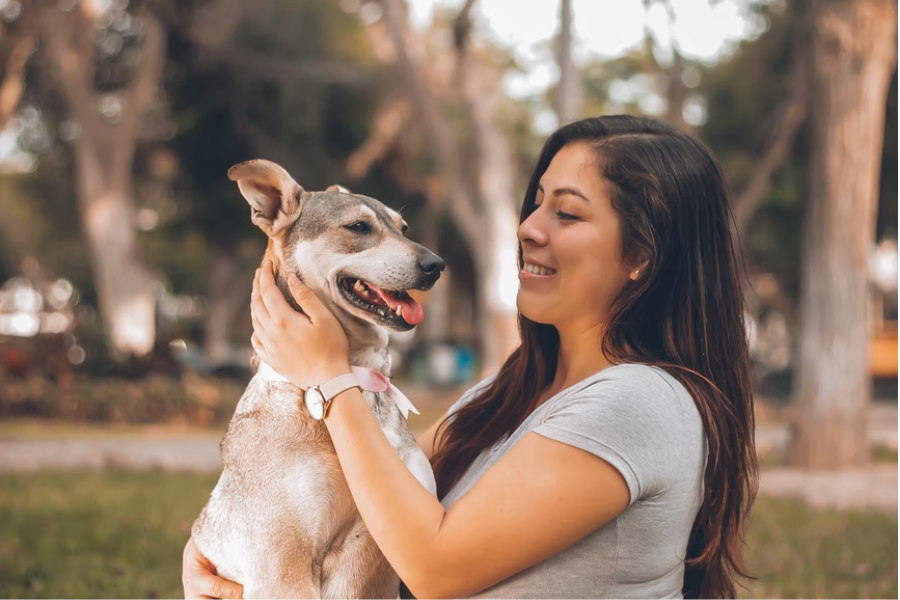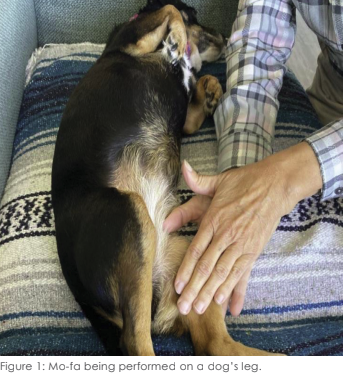Tui-na is an ancient Chinese form of medical massage that can have a profoundly healing effect on a range of conditions seen in veterinary practice, from osteoarthritis to respiratory symptoms.
Tui-na is one of the five arms of Traditional Chinese Medicine. The others include herbology, acupuncture, Qigong, and food therapy. Tui-Na is a safe and effective manual therapy, with no known side effects, used for disease treatment and prevention in people and pets. Although randomized placebo-controlled studies are limited, there is overwhelming evidence of historical use and appreciation for this specialized applied manual therapy.1 The active participation of the dog or cat owner is essential for optimum results. The use of Tui-na promotes open communication between the owner and the veterinarian, greatly facilitates the healing process, and honors the human-animal bond.2,3
Often referred to as Chinese medical massage, Tui-na dates back to the Shang Dynasty, around 1700 BC. “Tui” means push and “Na” means pull or lift. It uses massage, acupressure, traction, and manipulation techniques for the prevention and treatment of disease.2
WHY ADD TUI-NA TO YOUR PRACTICE?
Incorporating the art of Tui-na into your practice can benefit both your patients and clients, enhancing other treatments you already utilize. Tui-na can alleviate pain and stiffness and efficiently treat paralysis and hemiplegia. 4,5 It can improve respiratory symptoms such as nasal congestion and discharge, cough, and asthma, and can help treat vomiting, megaesophagus, and constipation. Tui-na can be incorporated into therapeutic plans for diabetic patients and those in renal failure. It can help with incontinence and prostate disorders, and help support animals with immunodeficiency. This is just a few applications for this ancient technique.
In this article, I will share what the animals have taught me are the most effective Tui-na techniques. In most cases, you will see results within a few days. Clients benefit from improved mental and emotional well-being because their animals are happier, healthier and more pain-free. They also receive healing effects from actually performing the movements on their animals, and often on themselves.
TUI-NA AND AGING
I have also witnessed the phenomenon of age reversal in the tissues of animals receiving Tui-na. This is due to the optimization of all organ systems, allowing animals to maintain exceptional health and active lifestyles far beyond their average lifespans. I have seen older patients who receive regular Tui-na from their caretakers appear much healthier than younger patients, who are already more compromised in function (circulation, neurology,
energy, and flexibility). William “Dub” Leigh describes the same observation from his work with people. In his book, Body therapy, he describes numerous cases of people in their 20s having tissues that are much more compromised in function and flexibility than those in people decades older.6,7 This is probably why the Chinese historically refer to Tui-na as the “Immortal Techniques.”8
TUI-NA TECHNIQUES AND ACTIONS
There are many Tui-na techniques. Those I am covering here are listed in the order I recommend doing them. They include Mo-fa (touching of the skin and muscle), Pai-fa (patting), Dou-fa (shaking) for joint and limb health, Nie-fa (pinching), and Na-fa (pulling) for whole body optimization. These techniques yield the greatest improvements in the shortest time.
Learn to listen to the animals and let them be your teacher as to how fast, slow, light, or firm they would like the movements done. Be sure and connect with your patients first, allowing them to get relaxed before you start. Tell them in your mind or aloud what you would like to do and ask them, just as you would a human, if it is all right to proceed. No one knows their bodies better than the animals themselves. Work with them, not on them. It’s appropriate to pause at times to let them integrate what you have offered. Wait for signs that they are ready to continue. This may be indicated by behaviors such as a big deep breath, a whole-body shake, or even a yawn.
Note that Tui-Na is contraindicated for open wounds, fractures, phlebitis, and around the lower abdomen of pregnant animals.
MO-FA (TOUCHING OF THE SKIN AND MUSCLE), PRONOUNCED “MOE-FA”
This technique stimulates the skin and underlying tissues in preparation for deeper work. Start at the top of the neck on one side and work caudally to the tail, going top to bottom,
from the dorsum to the feet. Be sure to do the legs and abdomen also.
This is a circular gliding movement with the palms and/ or fingers on the skin, going with the direction of the hair with both hands staying in contact. Practice by going firmer, lighter, faster, and slower. Every animal, on any given day, on any given part of the body, might prefer different depths of firmness or lightness and speed.
Mo-fa also helps with general circulation, as the subcutaneous connective tissue is very vascular. Begin with three to five minutes of Mo-fa (see Figure 1).
PAI-FA (PATTING), PRONOUNCED “PIE-FA”
This is a rapid patting motion using your palms and/or fingers, depending on the size of the animal. With smaller animals, you may want to use just one or two fingers. Your wrist must be loose and allowed to flex when doing Pai-fa. The palm should remain slightly concave.
Follow the same pattern as with Mo-fa, moving cranial to caudal and dorsal to ventral on both sides of the animal. Again, be sure to do the legs and abdomen. As you get
comfortable with this technique, begin to focus on the vibration going all the way through the body. As you do this you will find that your patting becomes softer, lighter and more effective as every cell in the body receives this healing vibration.
This is a good technique to practice on a family member or friend. Apply over the upper and mid back of the person until you get the vibration to be felt at the person’s solar plexus. You may find a desire to pat harder, but to be effective you in fact need to pat lighter with focused intent.
When done correctly, this technique can affect every cell in the body. Perform Pai-fa for one to five minutes, depending on the size of the animal (see Figure 2).
DOU-FA (SHAKING), PRONOUNCED “DOUGH-FA”
This shaking/vibrational movement is used on the legs. It is easiest if the animal will lie down on their side in a relaxed manner. Place your hands softly under the joints, supporting the stifle and hock in the rear, and the elbow and carpus in the front. You can also do this with the animal sitting or standing. Direct a light, rapid shake/vibration up the leg, into the shoulder, and into the spine.
This is my go-to technique for preventing/treating arthritis and joint problems. In several cases, I have seen a full reversal of long-standing osteoarthritis. Thirty seconds to one minute per leg is suggested (see Figures 3 and 4).
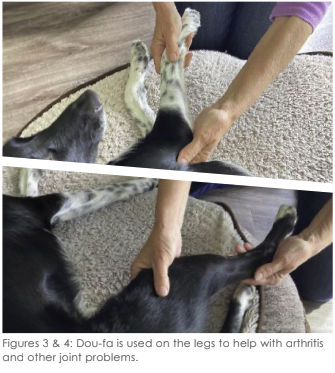
NIE-FA (PINCHING), PRONOUNCED “KNEE-FA”
This technique is known for regulating the spine with no side effects. Using the thumb and fingers, softly pinch and lift the skin and underlying fascia. I use this technique up the dorsum from the base of the tail to the neck to release adhesions along the spine.
I have found that this movement alone has a profound effect on overall body health by increasing Qi and blood flow, thus optimizing oxygen and nutrient delivery to every cell in the body (See Figure 5).
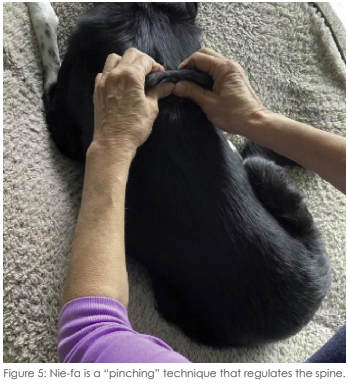
NA-FA (PULLING), PRONOUNCED AS WRITTEN
This technique is similar to Nie-fa, except you include the muscle when gently pinching and lifting. It is effective for helping with Qi and blood stagnation. I also use this technique
along the spine if adhesions prevent the use of Nie-fa. I will use Na-fa first up the dorsum from tail to neck to clear the adhesions and then follow with Nie-fa.2,3 (See Figures 6 and 7).
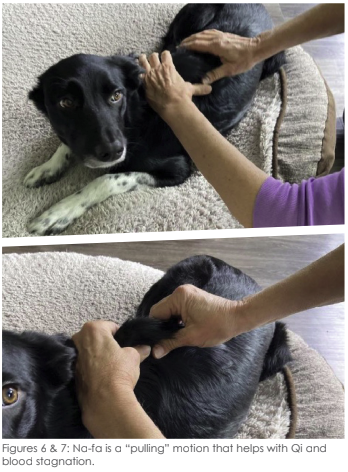
CLIENT PROTOCOLS FOR NIE-FA & DOU-FA
NIE-FA (PINCHING)
Two to four minutes, gradually increasing to six or more minutes, twice daily for ten days. Then once daily for two weeks. Then two to three times per week for life. Have clients use both hands, from the tail to the neck. I describe this as a skin roll up the spine, with the two thumb tips touching and the fingers “crab-walking” up the back without releasing the hold. If the skin is too tight, it is best to use Na-fa (pulling) first to loosen the skin and underlying fascia so the spinal skin roll can be done. If the animal is not receptive to beginning at the tail head, see if they will allow you to start at the neck and work caudally. Animals and their humans seem to mutually enjoy this technique.
DOU-FA (SHAKING)
Twice daily for two to four weeks initially. Then two to five times per week for life. Thirty seconds to one minute per leg. This is a good technique for reminding the client that less is
more. In their enthusiasm, I find clients often perform Dou-fa too long or vigorously, creating a patient that no longer enjoys the Tui-na.
CLIENT AFTERCARE AND HOMEWORK PROTOCOL
• I suggest that the client choose a time when they and their animal are relaxed. Before bedtime often works well.
• I demonstrate for the owner some recommended mindful grounding techniques to perform before starting — three to ten slow deep breaths, and a body scan to remove any
tension in their own body.
• I also get a feel for how many movements the owner is willing to commit to before assigning aftercare. If they are only able to perform two, I give them Nie-fa and Dou-fa.
Clients tell me that even just these two techniques, done for five minutes twice daily, can result in a noticeable difference within a week. See sidebar on previous page.
• If I feel the client will do more, I recommend Mo-fa and Pai-fa. Na-fa is given if the tissues along the spine are too tight for performing Nie-fa.
CONCLUSION
I have found the techniques of Chinese Tui-na to be a simple and effective way to facilitate the healing of a wide variety of problems seen in veterinary practice. As a result, I use it as my initial treatment for all animals I see. I also give every client homework, and have found this to be integral in achieving treatment success. Owners not only develop a deeper bond with their animals by applying a hands-on self-care program, but they also exponentially facilitate their pets’ speed of improvement and return to health.
I challenge you to consider using some of these Tui-na techniques on yourself and your family (two- and four-legged) to experience the magical results they produce. As well, offer one or two techniques to your clients to implement for themselves, and see what amazing feedback you receive.
References:
- Wang Z, Wang Q, Luan C, Chinese Massage Therapy. Jinan China: Shandong Science and Technology Press, 1990.
- Xie H, Ferguson B, Deng X. Application of Tui-na in Veterinary Medicine. 2nd ed. Reddick, FL: Chi Institute of Chinese Medicine, 2007:20-23, 52-53, 199-200.
- Seelye S. Chinese Tui-na – A Manual Therapy. In: Proceedings Annual Conference of the American Holistic Veterinary Medical Association. Abingdon, MD: AHVMA, 2021;387-391.
- Seelye S. TCVM treatment of intervertebral disc disease (IVDD) with complete hindlimb paralysis and loss of deep pain reflex. In: Clinical Application of Different TCM Schools & Thoughts in Veterinary Practice Proceedings of the 18th Annual International TCVM Conference. Reddick, FL: Chi Institute Press, 2018:239-242.
- Chen R (1997). Treatment of apoplectic hemiplegia by digital acupoint pressure – a report of 42 cases. J Tradit Chin Med. Sep;17(3):198-202.
- Seelye SK. The magic of Tui-na – complete reversal of shoulder arthritis along with age reversal in two eventing thoroughbreds. In: Traditional Chinese Veterinary Medicine for the Diagnosis and Treatment of Lameness and Pain in Dogs, Cats and Horses Proceedings of the 17th annual International TCVM Conference. Reddick, FL: Chi Institute Press, 2015;253-256.
- Leigh WS. Bodytheraapy: A Zen Approach to Bodytherapy (From Rolf to Feldenkrais to Tanouye Roshi). Honolulu, Hawaii: International Zentherapy Institute, Inc., 1994;93-110, 128.
- Han Ping. An-Mo-Tui-Na and Integrated Therapeutics, Beijing, China: Beijing Medical University Press, 1995.

